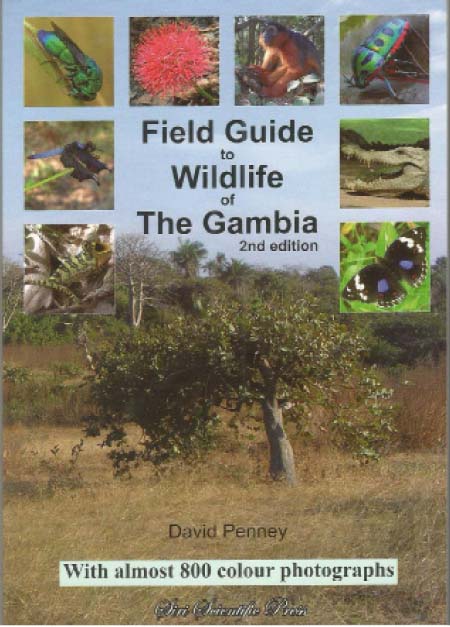
POLITICIANS, priest, professors, journalist: they’re all the ‘green’ now – aware of the beauty of the created world around us and the importance of cherishing it, and telling the rest of us how we should take care of the environment.
How far this massage has got across to the people in general is not clear. Some schools in the Gambia now have nature reserves and bird sanctuaries. Television programmes on wildlife are increasing popular. Yet see how many people are still indifferent to the disposal of waste, for example, apparently blind to the ugliness and unsanitary conditions that they create around themselves- not to mention those who cause forest fires and despoil the land in general. Such depredation pales besides the callous destruction of the natural habitat in, for example, the former Soviet Union, where the desire to extract oil as quickly as possible over-rode any consideration for the present and future environment-and for people’s health.
There’s much ‘missionary work to be done to enlist everyone’s interest and concern in their natural environment, and at the local level a book like David Penney’s is highly welcome.
Photographs galore
Dr penney is a retired zoologist living in the Gambia and visiting research fellow in the school of earth, atmosphere and environment sciences at the university of Manchester, in England.
His field guide to wildlife in the Gambia has the modest subtitle, ‘an introduction to common flowers and animals’. It can be slipped into the pocket, and is strong on colourphotographs (no fewer than 554 of them, six to a page) of flowering plants fungi, mammals and birds, reptiles and amphibians, insects, spiders, millipedes and centipedes.
Dr Penney remarks that the Gambia, with an area of only 11,295 square kilometers of dry land, is the smallest country in Africa. Its highestpointis less than 100 meters above sea level.
He describes the sub-tropical climate as ‘pleasant’. November to June features dry savannah winds, whereas from July to October there are heavy downpours, much over-night, and the country becomes ‘lusciously green’. The diversity of plant and animal life is most spectacular during the rainy season.Variety of habitats
The variety of the Gambia’s natural habitats includes marine and coastal, estuary and mangroves, brackish and freshwater river banks, swamp forest, freshwater swamps and other wetlands, forested areasfor example, (at Abuko and Tanji) and woodland , savannah, farms are urban environments. so there ;s a high biodiversity of indigenousplants and animals ‘but our knowledge of fauna and flora , ‘says Dr Penney, is far from complete’. Plants which are useful (for example, for building, for medical properties, as food, or are dangerous to people or crops) are the best known.
Dr Penney says that insects, spiders, scorpions, millipedes and centipedes are most poor-studied and so form the main focus of his guide. Many of the species he illustrates are ‘first records’ in this country, ‘and may even be new to science’. This then is substantially a book of pictures interspersed with short, clearly written material; ideal for those new to ‘nature watching’ as for those more experienced.
Diversity and beauty
On plants, Dr Penney says one cannot fail to be amazed at their diversity and beauty, particularly during the rainy season. Over 1,000 plant species – trees, shrubs, herbs and grasses- have been recorded. Many are slowly and difficult to miss, but others require a keen (and interested) eye.
Excluding domestic species, there are over 100 species of mammals - over thirty species of bats, alone. The majority of the other species are rodents, carnivores and ungulates (animals with horns). Many animals are nocturnal and secretive, including the tiny bush baby.
Lions giraffes and elephants lived in the Gambia in the past, but are now extinct (although carvings of them are sold to tourists as souvenirs!) .but leopards, hyenas and hippopotamuses still occur, albeit in smaller numbers than they once did.
The Gambia is celebrated for its bird diversity, which boasts more than 540 species because there’s an excellent existent guide to birds in Senegambia (by Clive Barlow and colleagues) Dr Penney includes only a few birds in this guide
‘Don’t feed the monkeys!’
Here’s a warning to our visitors: ‘don’t feed the monkeys!’ in their natural environment monkeys have all food they need. Feeding them increase the risk of catching fatal diseases such as rabies and herpes B, and makes the monkeys aggressive towards humans. Giving them food increases the size of the monkey population beyond the capacity of the forest, and encourages them to leave their natural habitat. Many of don’t know what ‘insect’ means. There are said to be three million insects’ species in Africa. Many are vectors of disease, or agricultural pests. Some – such as termites – eat away at wooden structures .some have powerful stings. But less than one per cent of insects cause problems for humans many of the remainder being positively beneficial: pollinating flowering plants, for example, on which we are dependent for food and oxygen. You can study insects almost everywhere in the Gambia.
Here’s a ‘taster’ of Dr Penney’s text, which is succinct and clear for those with only a slight knowledge of ‘nature’:
Termites (order Isoptera) live in large colonies and are highly social animals. Particularly large termite mounds may exceed four meters in height and exist for decades, possibly centuries in some species. Beware, these mounds often serve as a refuge for snakes, bats and other animals to escape the heat of the day, so never poke your hand in one!
Spiders are not ants. Dr Penney is an internationally recognised expert on spiders, and says, ‘almost nothing is known about the Gambian fauna. Indeed, many of the photographs here represent the first records of these spider families for the country.’
Not just for tourists
Altogether, then, this guide is a practical and stimulating, particularly for those who want to observe for themselves. It’s not just a book for tourist, but will arise the interest of many Gambians in the beauty and variety of local plants and animals.There’s a short warning at the end: ‘there are some serious conservation issues relating to this living museum of natural history.’ Dr Penney points out that the forestry and wildlife departments have limited resources and a great land area to protect throughout the country. ‘please help protect the magnificent natural heritage of The Gambian people and their visitors for many generations to come.’
Available at Timbooktoo Tel: 4494345


